-
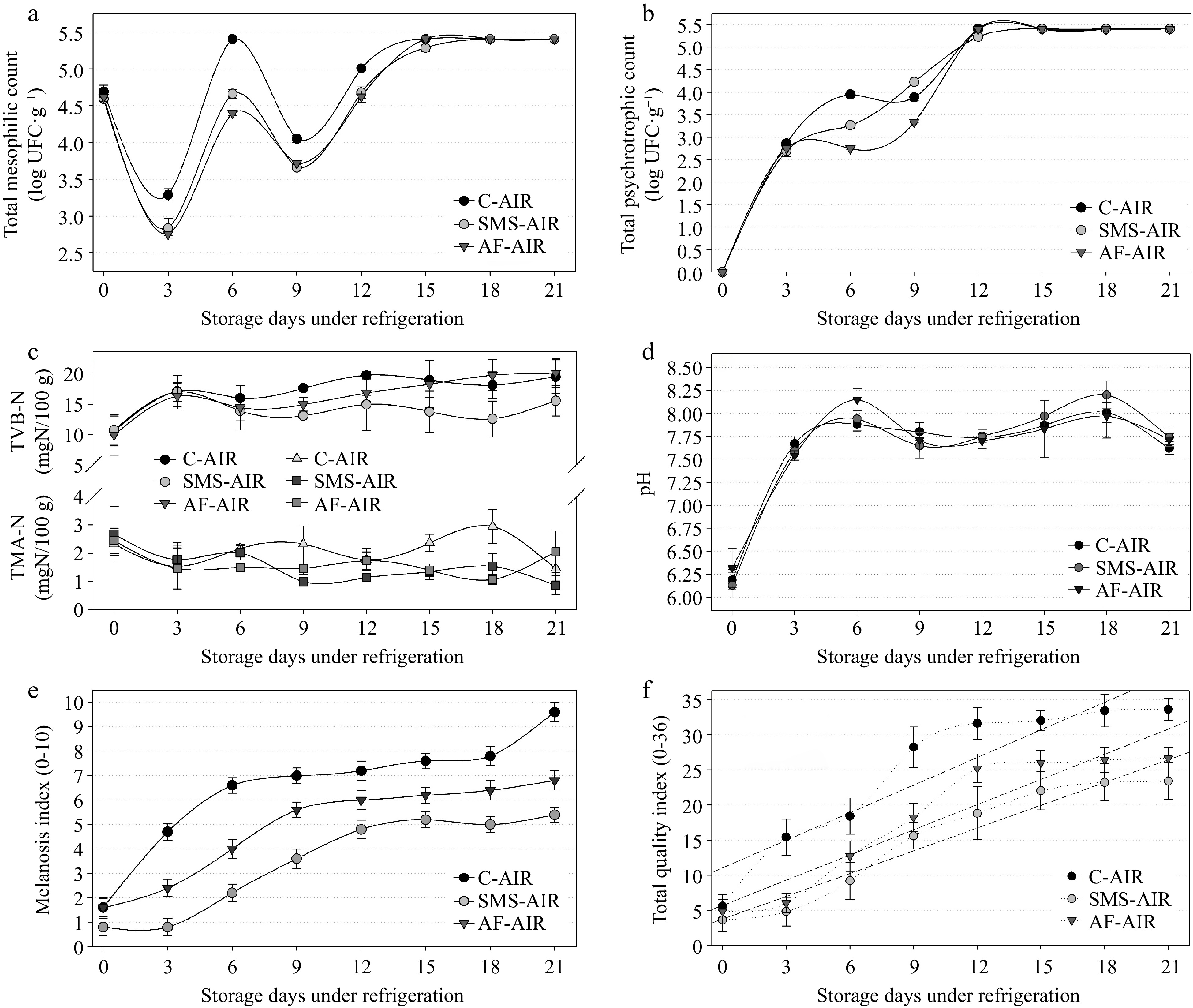
Figure 1.
Results of (a) total mesophilic count, (b) total psychrotrophic count, (c) nitrogen of total volatile bases (TVB-N) and trimethylamine (TMA), (d) pH, (e) melanosis index, (f) total quality index obtained in samples of white shrimp (L. vannamei), packed in atmospheric air, submitted to different antimelanosic treatments, stored for 21 d (4 ± 1 °C). C-AIR: without immersion bath, packed with atmospheric air; SMS-AIR: immersion in 1.25% SMS, packed with atmospheric air; AF-AIR: immersion in 10% acerola fruit solution, packed with atmospheric air; Error bars represent the standard error of three replicates.
-
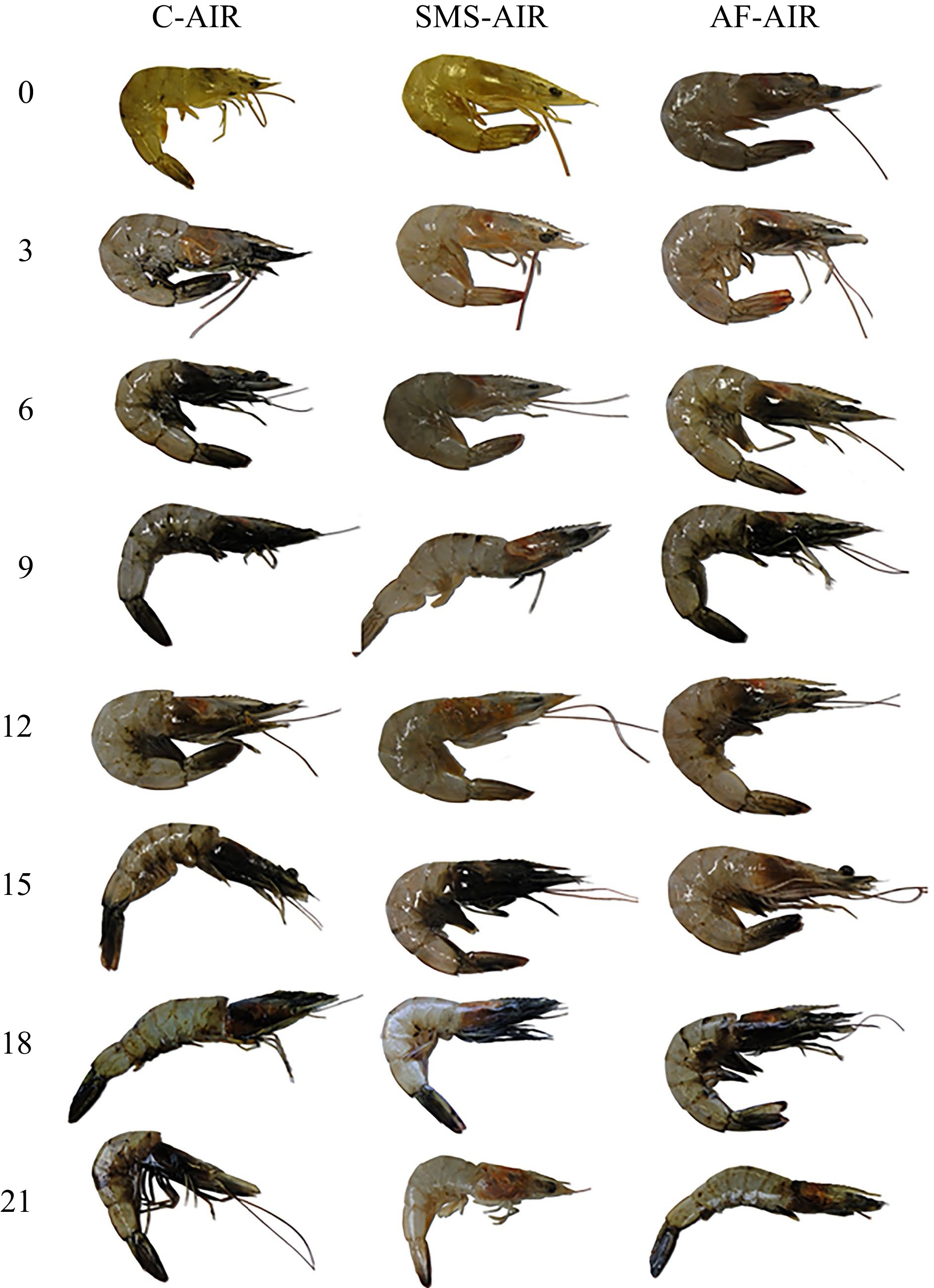
Figure 2.
Photographs of white shrimp (L. vannamei) packed in atmospheric air, submitted to different antimelanosic agents, and stored for 21 d (4 ± 1 °C). C-AIR: without immersion bath, packed with atmospheric air; SMS-AIR: immersion in 1.25% SMS, packed with atmospheric air; AF-AIR: immersion in 10% acerola fruit solution, packed with atmospheric air (photographs were taken after the shrimp were removed from their packaging for sensory evaluation).
-
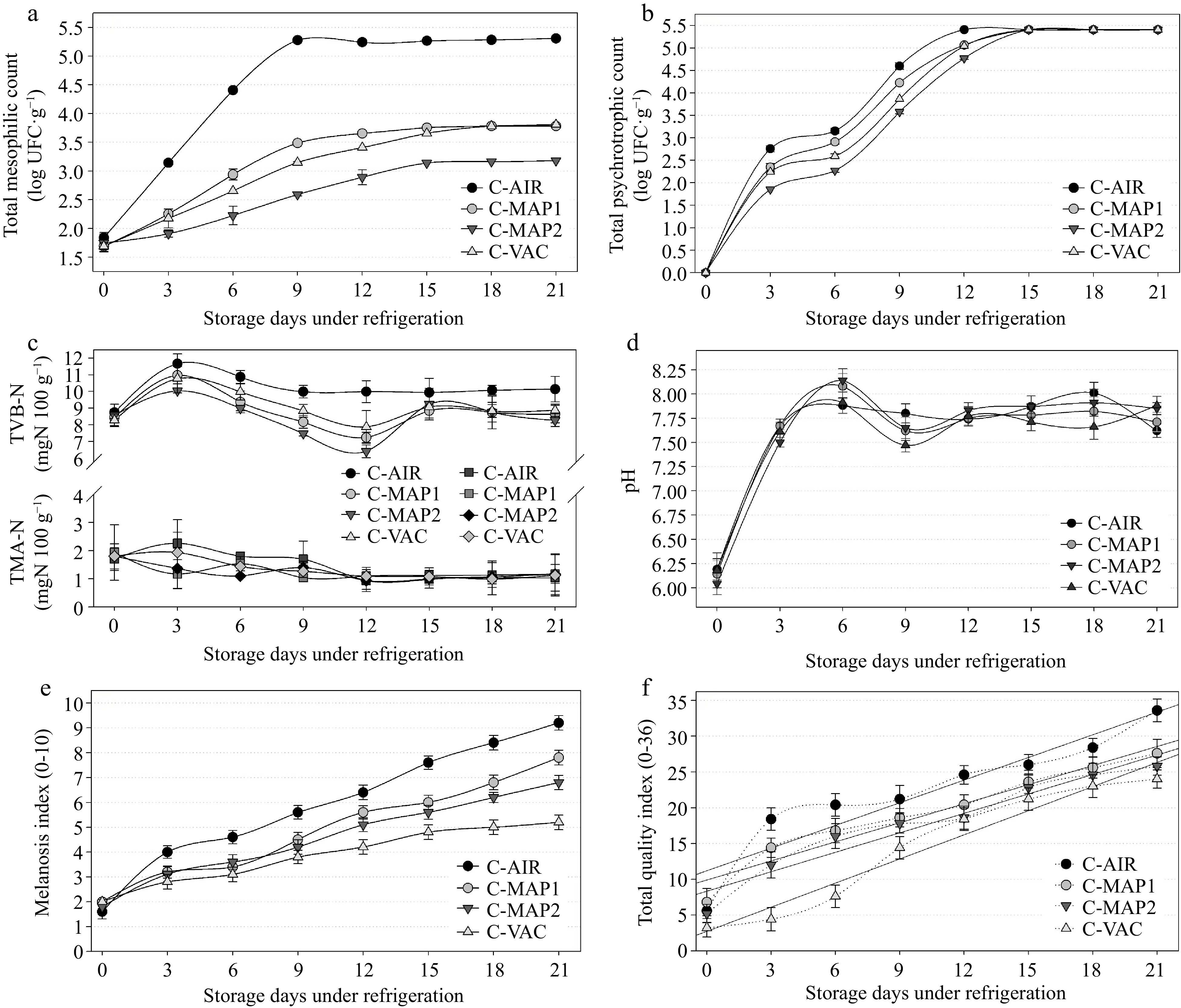
Figure 3.
Results of (a) total mesophilic count, (b) total psychrotrophic count, (c) nitrogen of total volatile bases (TVB-N) and trimethylamine (TMA), (d) pH, (e) melanosis index, (f) total quality index obtained in samples of white shrimp (L. vannamei), without different antimelanosic treatments, stored for 21 d (4 ± 1 °C). C-AIR: without immersion bath, packed with atmospheric air; C-MAP1: without immersion bath, packed with modified atmosphere1; C-MAP2: without immersion bath, packed with modified atmosphere 2; C-VAC: without immersion bath, packed with vacuum pack; Error bars represent the standard error of three replicates.
-

Figure 4.
Photographs of white shrimp (L. vannamei) without different antimelanosic treatments, stored for 21 d (4 ± 1 °C). C-AIR: without immersion bath, packed with atmospheric air; C-MAP1: without immersion bath, packed with modified atmosphere1; C-MAP2: without immersion bath, packed with modified atmosphere 2; C-VAC: without immersion bath, packed with vacuum pack (photographs were taken after the shrimp were removed from their packaging for sensory evaluation).
-
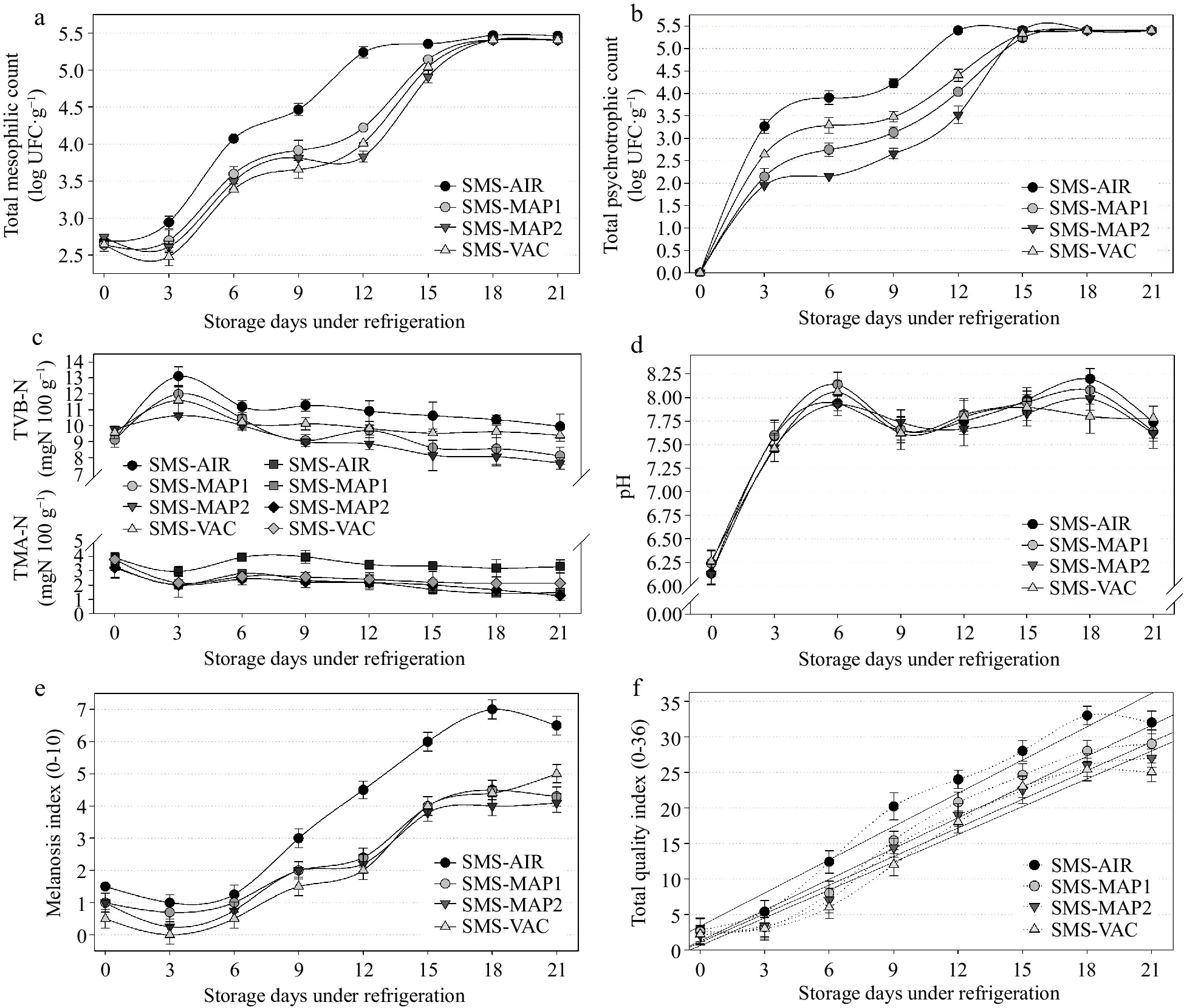
Figure 5.
Results of (a) total mesophilic count, (b) total psychrotrophic count, (c) nitrogen of total volatile bases (TVB-N) and trimethylamine (TMA), (d) pH, (e) melanosis index, (f) total quality index obtained in samples of white shrimp (L. vannamei) submitted to 1.25% sodium metabisulfite (SMS) treatment, packed in different atmospheric air, and stored for 21 d (4 ± 1 °C). SMS-AIR: packed with atmospheric air; SMS-MAP1: packed with modified atmosphere (70% N2 : 25% CO2 : 5% O2); SMS-MAP2: packed with modified atmosphere (25% N2 : 70% CO2 : 5% O2); SMS-VAC: vacuum packed. Error bars represent the standard error of three replicates.
-
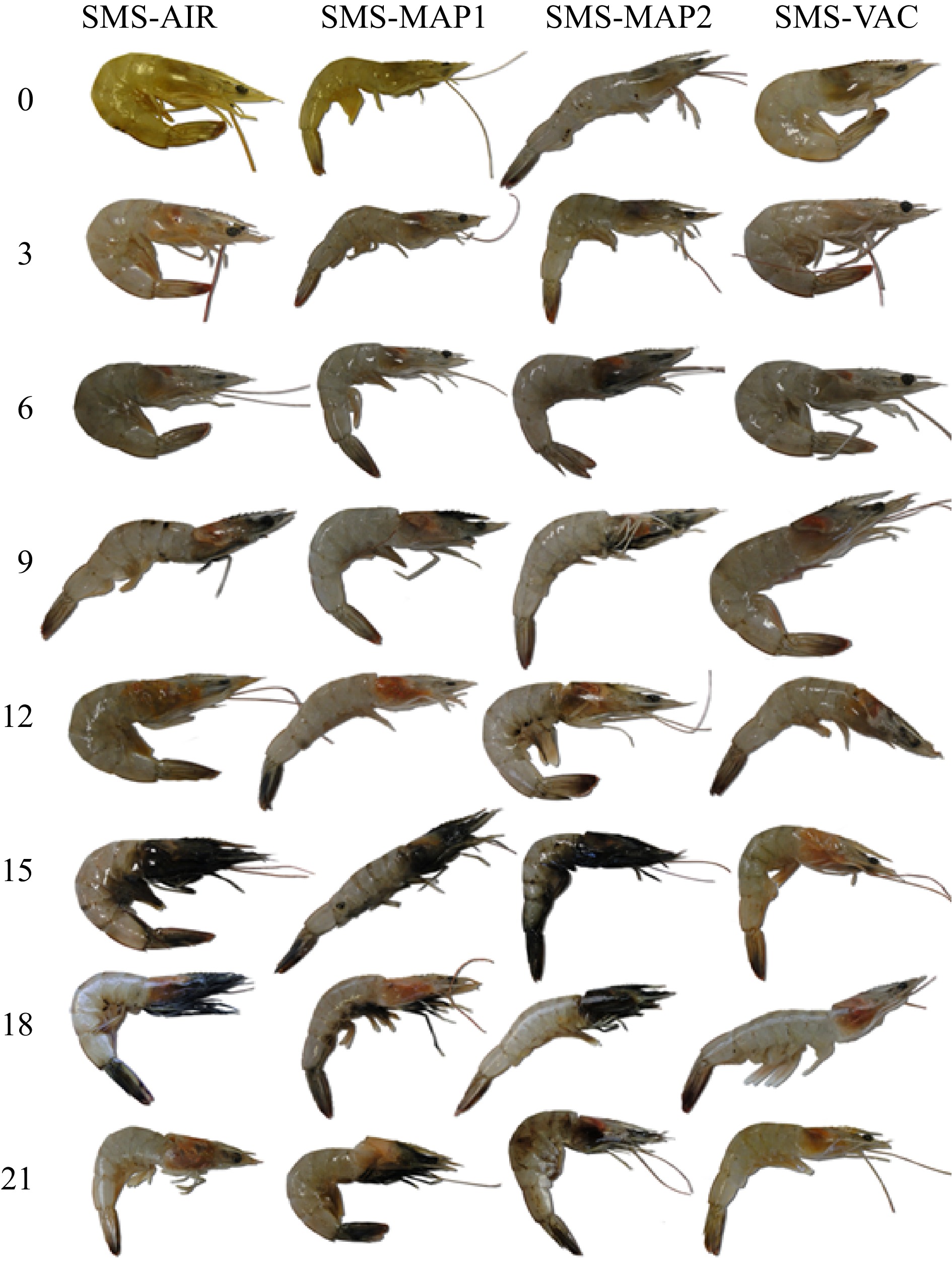
Figure 6.
Photographs of white shrimp (L. vannamei) submitted to 1.25% sodium metabisulfite (SMS) treatment, packed in different atmospheric air, and stored for 21 d (4 ± 1 °C). SMS-AIR: packed with atmospheric air; SMS-MAP1: packed with modified atmosphere (70% N2 : 25% CO2 : 5% O2); SMS-MAP2: packed with modified atmosphere (25% N2 : 70% CO2 : 5% O2); SMS-VAC: vacuum packed. Error bars represent the standard error of three replicates (photographs were taken after the shrimp were removed from their packaging for sensory evaluation).
-

Figure 7.
Results of (a) total mesophilic count, (b) total psychrotrophic count, (c) nitrogen of total volatile bases (TVB-N) and trimethylamine (TMA), (d) pH, (e) melanosis index, (f) total quality index obtained in samples of white shrimp (L. vannamei) submitted to 10% acerola fruit (AF) treatment, packed in different atmospheric air, and stored for 21 d (4 ± 1 °C). AF-AIR: packed with atmospheric air; AF-MAP1: packed with modified atmosphere (70% N2 : 25% CO2 : 5% O2); AF-MAP2: packed with modified atmosphere (25% N2 : 70% CO2 : 5% O2); AF-VAC: vacuum packed. Error bars represent the standard error of three replicates.
-
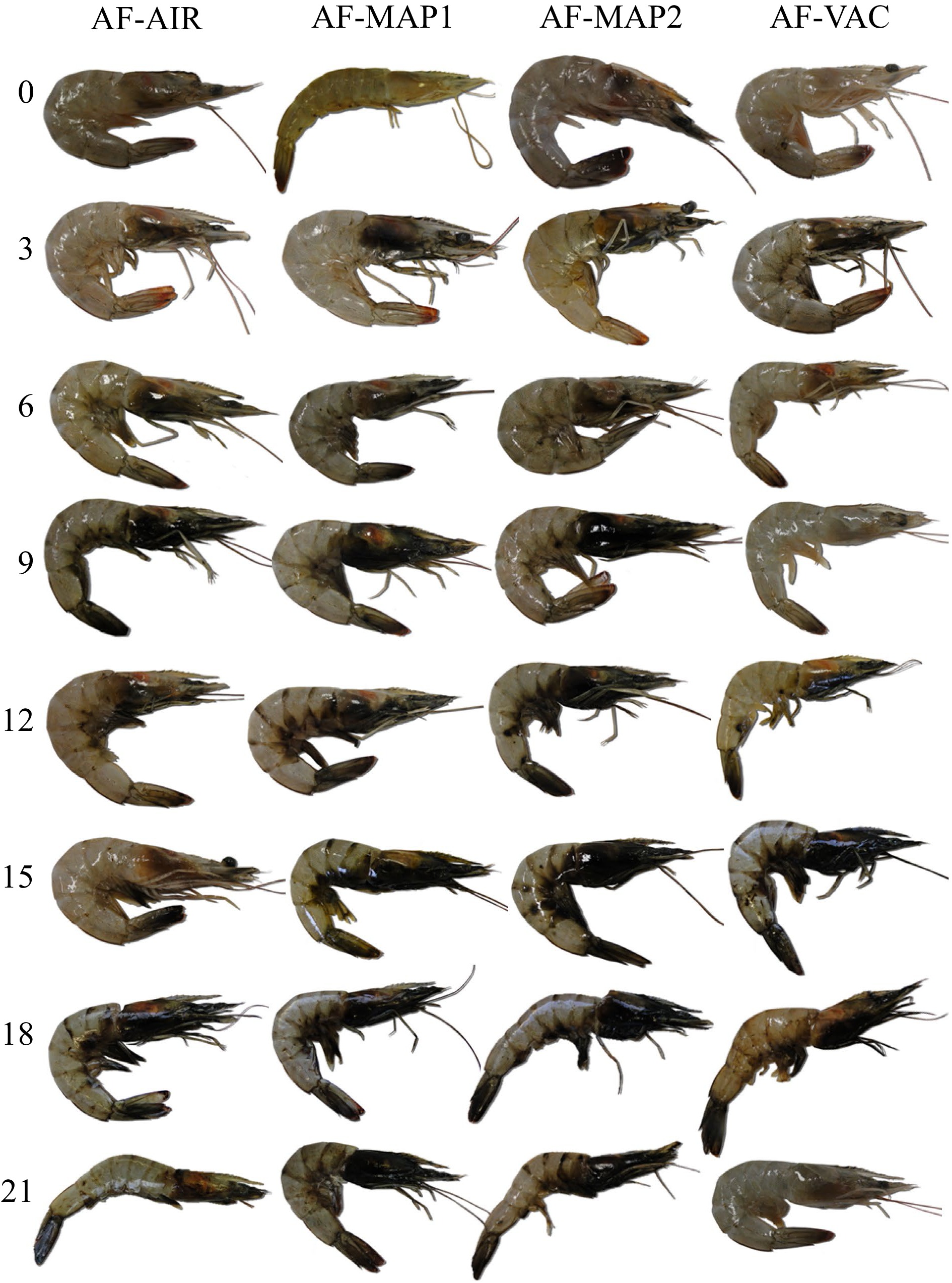
Figure 8.
Photographs of white shrimp (L. vannamei) submitted to 10% acerola fruit (AF) treatment, packed in different atmospheric air, and stored for 21 d (4 ± 1 °C). AF-AIR: packed with atmospheric air; AF-MAP1: packed with modified atmosphere (70% N2 : 25% CO2 : 5% O2); AF-MAP2: packed with modified atmosphere (25% N2 : 70% CO2 : 5% O2); AF-VAC: vacuum packed (photographs were taken after the shrimp were removed from their packaging for sensory evaluation).
-
Package conditions Control Sodium metabisulphite Acerola fruit Air (Atmospheric air) C-AIR SMS-AIR AF-AIR MAP1 (70% N2 : 25% CO2 : 5% O2) C-MAP1 SMS-MAP1 AF-MAP1 MAP2 (25% N2 : 70% CO2 : 5% O2) C-MAP2 SMS-MAP2 AF-MAP2 Vacuum C-VAC SMS-VAC AF-VAC C-AIR: without immersion bath, packed with atmospheric air; SMS-AIR: immersion in 1.25% sodium metabisulphite (SMS), packed with atmospheric air; AF-AIR: immersion in 10% acerola fruit solution, packed with atmospheric air; C-MAP1: without immersion bath, packed with modified atmosphere1; SMS-MAP1: immersion in 1.25% SMS, packed with modified atmosphere 1; AF-MAP1: immersion in 10% acerola fruit solution, packed with modified atmosphere 1; C-MAP2: without immersion bath, packed with modified atmosphere 2; SMS-MAP2: immersion in 1.25% SMS, packed with modified atmosphere 2; AF-MAP2: immersion in 10% acerola fruit solution, packed with modified atmosphere 2; C-VAC: without immersion bath, packed with vacuum pack; SMS-VAC: immersion in 1.25% SMS, packed with vacuum; AF-VAC: immersion in 10% acerola fruit solution, packed with vacuum. All packages were composed of a Combitherm® film (Wolff Walsrode AG, Germany) 0.115 mm thick and grammage 115.0 g·m−2, with the following gas permeability characteristics: water vapor 2.5 g·m−2·day−1; nitrogen <0.1 cm3·m−2·day−1·bar−1; oxygen 0.8 cm3·m−2·day−1·bar−1; carbon dioxide 0.8 cm3·m−2·day−1·bar−1. Table 1.
Treatment combinations of samples submitted to antimelanosic and packaging systems.
-
Quality
parameterDescription Score Odor Fresh, smooth as seaweed 0 Faint, reminiscent of sea salt 2 Light ammonia sent 4 Heavy ammonia sent, putrid 6 Melanosis Absent 0 Slight, small isolated black spots, occurring in up to 50% of the sample's shrimp 2 Moderate, small isolated black spots, occurring in over 50% of the sample's shrimp 4 Moderate, larger black stains, occurring in up to 50% of the sample's shrimp 6 Heavy, larger black stains, occurring in over 50% of the sample's shrimp 8 Heavy, blackening of the shrimp, occurring in 100% of the sample's shrimp 10 Texture Normal 0 Softened 2 Shell Strongly adhered 0 Mildly adhered 2 Weakly adhered 4 Head Strongly adhered 0 Mildly adhered 2 Weakly adhered 4 Appearance Excellent 0 Great 2 Good 4 Bad 6 Awful 8 Unacceptable 10 Total Quality Index (TQI) 0−36 Adapted from Oliveira et al.[20] . Table 2.
QIM scheme developed especially for this research.
-
Groups Linear regression model r2 Shelf life (d) C-AIR y = 10.67 + 1.1890 x 0.8795 10.7 (See Fig. 1e) SMS-AIR y = 3.30 + 1.3670 x 0.8497 14.7 AF-AIR y = 5.70 + 1.2860 x 0.9456 13.7 C-AIR y = 10.67 + 1.1890 x 0.8795 10.7 (See Fig. 3e) C-MAP1 y = 9.50 + 1.1330 x 0.9184 12.3 C-MAP2 y = 11.63 + 0.9110 x 0.8403 12.9 C-VAC y = 9.53 + 1.0250 x 0.8796 13.5 SMS-AIR y = 3.30 + 1.3670 x 0.8497 14.7 (See Fig. 5e) SMS-MAP1 y = 6.30 + 1.1095 x 0.7624 15.4 SMS-MAP2 y = 2.83 + 1.2310 x 0.8200 16.7 SMS-VAC y = 1.23 + 1.1970 x 0.9500 18.5 AF-AIR y = 5.70 + 1.2860 x 0.9456 13.7 (See Fig. 7e) AF-MAP1 y = 7.17 + 1.1510 x 0.9317 14.1 AF-MAP2 y = 6.84 + 1.1476 x 0.9035 14.4 AF-VAC y = 3.67 + 1.3420 x 0.8879 14.7 y = maximum acceptable TQI (65% of total, i.e., 23.4); x = refrigerated days; r2 = coefficient of determination. Table 3.
Results from the linear regression and estimated shelf life after 21 d of storage (4 ± 1°C).
Figures
(8)
Tables
(3)